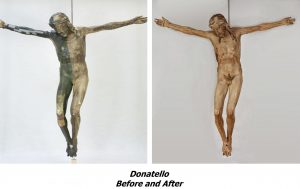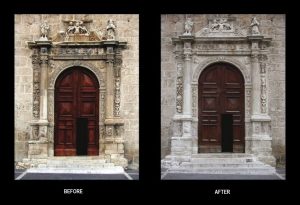Principles of restoration
The term “restoration” refers to a wide range of operations carried out on a wooden object or artefact such as cleaning, disinfection, carpentry and finishing or polishing.
There is much discussion among professional restorers, as to the best way to restore an ancient artifact, whether it is better to minimize the intervention on the structure, keeping it as much as possible in the condition it is in, or to intervene in a more incisive way, even replacing important pieces by size (in a percentage however, not exceeding 30% of the entire piece) thus returning it close to its original condition.
In the first case we speak of “conservative restoration” which is what is used most in “fine” arts not only, of course, for antique wooden artefacts, but for any work of art, including frescoes.
In the second case we speak of “antique restoration”. Antique restoration is performed on more recent vintage artifacts and that must return to being as close as possible to what they were at the time of their creation. They are to be put back in use and be functional.
The original sheen is conserved only if it is perfect condition, otherwise it is better to strip off the paint and the re-polish and coat it with a good encaustic. Very damaged parts are replaced and the restoration work is performed using appropriate and contemporary wood, i.e. should be of the same essence and when possible from the same period of the cabinet.
Broken locks are restored or replaced with locks in the same style as well as handles and hardware. It is the type of the restoration that is typically done for antique dealers who must resell the item or for customers who wish to put the item in the house and demand that it be in good condition.
Between these two “extremes” there are many ways to restore an artifact. Antique restoration can be done for example maintaining the artifact or object’s patina. Ultimately however, the choice of restoration type is done on a case-by-case basis and making the decision with the customer or the friend who has entrusted the object to be restored. This last point is crucial. It is imperative to understand what the customer wants and transmit equally clearly the type of intervention that is to be carried out and what results are expected.
It is important, at this point, to point out that professional restoration is not arbitrary, as in Italy for example, it is governed by “RESTORATION PAPER” issued by the Ministry of Fine Arts in 1987 that while not binding, provides precise guide lines on how carry out restoration.
The points mentioned, though they may be useful for getting an idea of what is meant by restoration, have a purely academic value. If the intention is to bring back to life relatively cheap manufactured goods, i.e. furniture and various artifacts that can be found in the attic, in a street market or, auction markets, it is unlikely to find rare pieces of furniture of great value as they will have been allocated to connoisseurs and antiquarians.
One important rule is the following: if in possession of rare and valuable antique furniture it will certainly be appropriate to turn to professionals restorers who have the experience, the expertise and the means to carry out a perfect restoration. Restoration done poorly will significantly deteriorate the value of the object.
What exactly is the difference between an antique artifact and an old one?
First it should be stated that for antique furniture the term “old” is not derogatory. Something, that has been produced in the last hundred years is considered old, while something produced prior to that is considered antique. Naturally the line between the two is not always so clear; a grandmother’s dresser can be as beautiful and of equal value to a piece of antique furniture.
Renewing however does not mean taking something back to its original state, but rather to restore while respecting the aging, the wear and the history of the piece in question. It is necessary therefore to learn to make a diagnosis of the damage, to treat the wood, to choose the right equipment, but above all to be armed with a lot of patience.
Care should be taken to repair damage and reinstated only parts which have been destroyed. Nothing further should be touched. The rule of respect for the artifact applies both to an antique object and to an old one. The restoration and renewal is a real art, and like all arts it requires study. Therefore, we must spend time to do some good reading where are illustrated styles and creation features, during various eras. Also a carpentry manual will definitely help you in practice, crucial for a good result.
Moreover, it can be very helpful to buy a Carpentry Handbook for your practice, crucial for a good result of your work. As stated above, in order to carry out good restoration it is necessary to intervene in a more or less incisive way on the manufactured article. Interventions range from stripping to pest control to the reconstruction of missing pieces.
It’s very important to emphasize that the renewal and restoration work should be done on small pieces of old furniture of low value. If it is necessary to restore antique and valuable furniture, this should be carried out by professional restorers, who have the required experience, skills and expertise.



